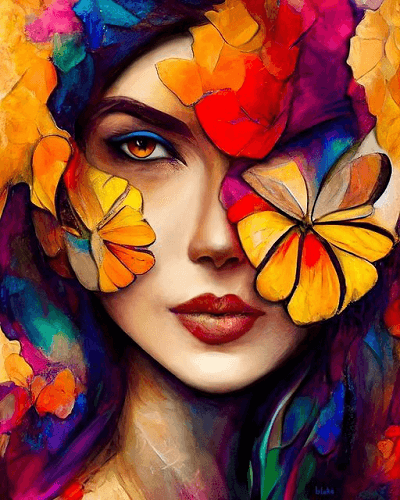Getting Started on a Visual Journey Via the Lyrical Analyses of Nature in Impressionist Landscapes
Each brushstroke, each play of light and shadow, and each color option in their works talks quantities concerning the artists' deep connection to nature and their capacity to translate its appeal onto the canvas. As we check out the lyrical analyses of nature in Impressionist landscapes, we are invited to immerse ourselves in a globe where truth and emotion link, offering a glimpse into the artists' extensive recognition for the all-natural world.
The Exciting Brushstrokes of Claude Monet
Claude Monet's mastery of brushstrokes goes beyond plain technique, imbuing his landscapes with a spiritual top quality that enthralls and astounds visitors - trump art. His ingenious use shade and light, integrated with his distinctive brushwork, creates a feeling of activity and life within his paintings. Monet's renowned series of works portraying water lilies and his legendary haystacks display his ability to record the fleeting effects of light and atmosphere

Embracing Light and Darkness With Camille Pissarro
Symbolizing a similar reverence for the interplay of light and darkness, Camille Pissarro's artistic vision unfolds as a harmonious exploration of the all-natural globe's luminous subtleties. Pissarro, a key figure in the Impressionist activity, masterfully recorded the dynamic partnership in between light and shadow in his landscapes. His experienced use of color and brushwork permitted him to communicate the subtle shifts in light that define various times of day and seasons.
Pissarro's paintings usually include spotted sunlight filtering via fallen leaves, casting elaborate patterns of light and shadow on the planet listed below. In jobs such as "Hoar Frost, the Effect of Snow, Pontoise," Pissarro skillfully portrays the crisp brightness of winter season sunlight juxtaposed with the trendy darkness that define the snowy landscape. By embracing both light and shadow in his compositions, Pissarro invites customers to submerse themselves in the all-natural beauty and transient results of light worldwide around them.

With Pissarro's jobs, we are advised of the transformative power of light and darkness, welcoming us to pause and value the short lived minutes of elegance existing in the everyday landscapes that border us.
A Symphony of Color Styles by Edgar Degas
Edgar Degas coordinates a lively harmony of shades in his masterful art work, instilling his structures with a dynamic interplay of tones that captivate the visitor's stare. Known primarily for his ballet professional dancers and intimate scenes of Parisian life, Degas adeptly adjusted colors to share mood and movement in his paints. trump art. His usage of bold, different colors and refined tonal variants browse around this site created a sense of deepness and vibrancy within his jobs
Degas' color combination frequently consisted of abundant blues, deep greens, and cozy oranges, which he used with confident brushstrokes to record the significance of his subjects. Whether depicting a ballerina mid-performance or a group see here of friends conversing at a cafe, Degas' shades not just showed the scene yet also evoked a feeling of emotion and energy.
Moreover, Degas' trial and error with light and darkness included an additional layer of complexity to his shade make-ups, boosting the general environment of his paintings (trump art). Via his skillful manipulation of color, Degas produced an aesthetic symphony that remains to resonate with customers today
Exploring Nature's Serenity With Berthe Morisot
Berthe Morisot's creative vision provides a tranquil separation from the vivid shade harmonies of Edgar Degas, as she catches the tranquility of nature in her evocative landscapes. Understood for her delicate brushwork and intimate representations of everyday life, Morisot's landscapes exude a sense of peace and consistency.
Morisot's paintings usually feature soft, low-key tones that convey a feeling of peace and tranquility. Her jobs, such as "The Cradle" and "Summer season's Day," display her capability to record the subtle elegance of nature in such a way that is both reflective and soothing to the audience.
Unlike several of her Impressionist counterparts who concentrated on bold colors and dynamic structures, Morisot liked to produce gentle, reflective scenes that invite the viewer to reflect and pause. Through her skillful use light and darkness, Morisot produces a feeling of harmony that reverberates with the visitor on a deep emotional degree.
The Psychological Landscapes of Vincent Van Gogh
Vincent Van Gogh's landscapes clearly communicate a depth of emotion with their dynamic brushwork and meaningful use color. The Dutch post-impressionist musician is renowned for his capability to record intense and raw feelings in his paintings, going beyond typical depictions of nature. Van Gogh's turbulent individual life, noted by mental health struggles, greatly influenced his art, instilling his landscapes with a sense of anxiousness, sorrowful, or spirit.
In jobs such as "Starry Night" and "Wheatfield with Crows," Van Gogh's swirling brushstrokes and dynamic shade selections stimulate an extensive emotional response from audiences. The turbulent skies and flustered landscapes in his paintings mirror his internal turmoil and emotional turbulence, welcoming audiences to explore the complexities of his mind.
Van Gogh's unique aesthetic language, defined by exaggerated viewpoints and vibrant use shade, develops landscapes that reverberate with customers on read the article a deeply emotional level. Through his art, Van Gogh invites us to see nature not just as an exterior reality yet as a mirror of our innermost sensations and emotions.
Final Thought
Finally, the impressionist landscapes of artists such as Claude Monet, Camille Pissarro, Edgar Degas, Berthe Morisot, and Vincent Van Gogh use a one-of-a-kind and fascinating visual interpretation of nature. Via their use brushstrokes, light, feeling, and shade, these artists have actually produced a symphony of pictures that stimulate a feeling of serenity and appeal in the all-natural globe. Their works proceed to motivate and enchant audiences with their lyrical interpretations of the landscapes around us.
Each brushstroke, each play of light and darkness, and each shade selection in their jobs speaks quantities regarding the musicians' deep link to nature and their capability to convert its appeal onto the canvas. His cutting-edge usage of color and light, integrated with his distinct brushwork, creates a sense of activity and life within his paints. His proficient use of shade and brushwork allowed him to communicate the refined changes in light that specify various times of day and periods.

Comments on “A Deep Study the Most Famous Trump Artworks of Recent Years”